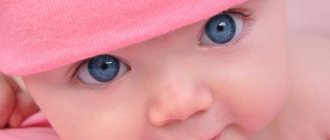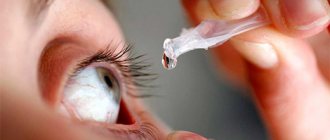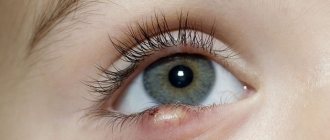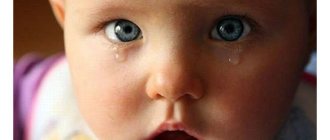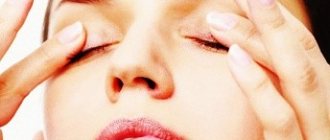Possible causes of swelling of the upper eyelids in a child
Most often, swelling of the upper eyelids in children of different ages is associated with infectious diseases and mechanical damage to the visual organs.
Experts identify the following main reasons that cause swelling of the eyelids.
Conjunctivitis
With conjunctivitis, the mucous membrane that covers the inner surface of the eyelids and sclera becomes inflamed. The development of the disease is provoked by:
- bacterial microorganisms (pneumococci, gonococci);
- fungi (the disease develops with candidiasis, coccidosis, rhinosporidosis);
- viruses (herpes virus, adenovirus);
- irritation of the organs of vision by physical and chemical factors (dust, ultraviolet radiation, smoke);
- allergic reactions of the body associated with taking certain medications, the activity of helminths or demodex mites, exposure to household dust, pollen of flowering plants.
In addition to swelling of the eyelids, the following are observed:
- increased sensitivity to light;
- discharge of pus or mucus from the eyes;
- sensation of a foreign body in the eye;
- burning;
- pain;
- itching;
- lacrimation.
Phlegmon
Cellulitis of the eyelid is an inflammatory purulent process with a severe course, which begins to develop from the subcutaneous tissue of the eyelid. It can spread to both the upper and lower eyelids. Cellulitis does not affect the structure of the orbit.
The disease is often diagnosed in children under 3 years of age who have had inflammatory diseases of the upper respiratory tract or otitis media.
The reasons for the development of a purulent inflammatory process are:
- injuries to soft tissues, which entail a violation of their integrity and create conditions for the penetration of pathogenic microorganisms (pyogenic streptococcus, Staphylococcus aureus);
- purulent diseases of the ENT organs (sinusitis, pharyngitis, chronic sinusitis, ethmoiditis);
- entry of a foreign body into the eye and associated damage to the inside of the eyelid;
- the presence of stye on the eyelid;
- the presence of carbuncles and boils on or near the eye.
In addition to swelling of the eyelid, phlegmon manifests itself in the following:
- redness of the skin over the area of the inflammatory process;
- pain;
- thickening of the skin on and around the affected area;
- decreasing viewing angle;
- dizziness;
- headache;
- nausea.
Barley (hordeolum)
Barley on the eye is an infectious process, the development of which is associated with the penetration of pathogenic microorganisms into the eyelash follicle or into the meibomian gland.
In children, stye often occurs due to the fact that they neglect hygiene standards and touch their eyes with dirty hands, which several times increases the risk of developing an infectious process.
The development of a purulent process is caused by Staphylococcus aureus, a pathogenic microorganism that spreads through contact, household, airborne, medical and nutritional routes. It enters the body due to violations of personal hygiene standards, as well as weakened immunity.
The risk factors in this case are:
- lack of sleep and rest;
- vitamin deficiency;
- frequent stressful situations within the family;
- regular acts of hunger strike;
- hypothermia.
Barley is expressed in symptoms such as:
- swelling of the eyelid, local compaction;
- redness of the area where the inflammatory process develops;
- formation of a seal on the eyelid with an abscess on the surface;
- pain, burning and itching at the site of compaction;
- increased tearfulness.
If hordeolum occurs against a background of severe weakening of the body, then additional symptoms such as headaches, general weakness, increased body temperature, and nausea occur.
Dacryocystitis
This ophthalmological disease is an inflammatory process in the lacrimal sac. Separately, we consider such a clinical form as dacryocystitis of newborns. Its danger lies in the increased risk of developing complications such as meningitis, brain abscess, purulent-septic processes in the soft tissues of the orbit.
The main causes of dacryocystitis:
- congenital pathologies of the lacrimal ducts;
- polyps in the nasal cavity;
- sinusitis;
- chronic rhinitis;
- ARVI;
- fractures of the bone structures of the nose.
With dacryocystitis, in addition to swelling of the eyelids, persistent lacrimation, discharge of purulent or mucopurulent secretion, narrowing or complete closure of the palpebral fissure are observed.
A bite of an insect
Mosquitoes and other insects (midges, bees, hornets) can bite a child in the eyelid or eyebrow area. This leads to swelling and redness of the tissues, severe itching and pain.
The danger of insect bites is due to the fact that the child may be allergic to them. In this case, the symptoms become pronounced: swelling can spread to the entire face, body temperature rises, nausea, vomiting and diarrhea occur.
Injuries
Swelling of the eyelid of a traumatic nature is caused by the impact of mechanical factors on this area. The tissues of the eyelid are very thin and delicate, so even a minor traumatic impact can cause swelling and pain.
Preventive recommendations
To prevent swelling and redness of the upper eyelid, it is necessary to carry out a set of preventive measures. This is especially true for newborns and infants. It is necessary to maintain personal hygiene and the hygiene of the child. Every morning, wash your baby, wash your hands as often as possible with antibacterial soap, and your child’s with baby gel. Walks in the fresh air are shown every day for several hours. It is necessary to prevent rubbing your eyes with dirty hands. During an epidemic, it is important to minimize visiting crowded places, not to self-medicate, only consult a doctor. If you are allergic to pets, give your pet to friends, and if you are irritated by food, exclude them completely.
Treatment of a swollen upper eyelid in a child
Treatment of eyelid swelling in children should begin only after visiting a doctor. Approaches to therapy depend on what disease was diagnosed in the patient.
For conjunctivitis, certain groups of medications are prescribed. They are selected based on the nature of the disease:
- For viral conjunctivitis, Acyclovir or Zovirax ointments and antiviral eye drops (Poludan, Trifluridine) are prescribed: drugs are selected based on the microorganism that caused the development of the disease.
- For bacterial conjunctivitis, local medications containing antibiotics (tetracycline ointment, chloramphenicol drops) are prescribed.
- In case of allergic conjunctivitis, antihistamine and anti-inflammatory drops (Allergodil, Cromohexal) are prescribed. Read more about the treatment of allergic conjunctivitis here.
It is recommended to wash the eyes with chamomile decoction.
For congenital dacryocystitis, Massage for dacryocystitis is carried out to remove contents from the lacrimal sac and cleanse the eyes of mucus and pus.
To treat this disease, the following drops are prescribed:
- Collargol (bactericidal and anti-inflammatory agent);
- Tobrex (strong antibacterial and bactericidal agent);
- Oftalmoferon (antiviral and antimicrobial drug);
- Vitabact (antimicrobial agent);
- Signecef (antibacterial agent).
In case of secondary disease, the possibility of surgical intervention is considered. Surgical treatment is carried out by laser or endoscopic intervention.
Barley in children is treated as follows:
- drops with an antibacterial effect (Tobrex, Levomycetin, Gentamicin) are instilled into the eyes;
- lubricate the eyelash edges with ointments containing antibiotics (tetracycline or erythromycin ointment);
- apply hormonal ointments to suppress the inflammatory process (hydrocortisone ointment).
After opening the barley, the pus is removed using Furacilin.
When phlegmon , complex treatment is prescribed. The course of drug therapy includes the use of the following drugs:
- antibacterial eye drops (Norfloxacin, Colbiocin);
- systemic antibacterial drugs (Erythromycin, Cyclosan);
- herbal immunomodulators for oral administration (ginseng, licorice, echinacea).
At the stage of swelling and tissue hardening, physiotherapy is prescribed: ultra-high frequency therapy and dry heat.
Surgical intervention is prescribed when pus accumulates, which can spread beyond the affected area and cause sepsis and other health and life-threatening complications. The phlegmon is cut in the zone of greatest softening.
After all the pus is removed, drainage is done and a sterile dressing is applied.
If the cause of eyelid swelling is an insect bite , then you need to make sure that the child does not develop an allergic reaction. If you experience allergy symptoms, you should immediately consult a doctor.
In other cases, the following means are used to treat the area of edema:
- non-steroidal anti-inflammatory drug in tablet form (Paracetamol, Nimesil, Ibuprofen);
- antihistamine tablets (Zyrtec, Suprastin), in case of severe swelling, it is recommended to take this drug every 3-4 hours;
- a disinfectant (for example, chlorhexidine), which needs to be used to treat the bite site and areas of skin near it;
- antihistamine or hormonal ointments that need to be applied to areas of swelling (hydrocortisone ointment, Cycloderm or Fenistil gel).
Such folk remedies as peeled slices of raw potatoes, parsley, and cold cabbage leaves are good for swelling of the eyelids. They need to be applied to the swelling area.
In case of eyelid injury, first aid must be provided to the victim: if there is a violation of the integrity of the skin, treat this area with a disinfectant. After this, cold is applied to the affected area (an ice cube wrapped in several layers of cotton fabric). Then you need to see a doctor.
What to do if your eye is swollen?
If parents discover that their child has a swollen eye, they need to carefully examine the affected area. It is necessary to remember what the child was doing the day before (hitting, sitting at the computer a lot), whether there was contact with sharp objects, new cosmetics, insects (for example, if the family is on vacation in exotic countries). You also need to examine your eyes and understand whether the swelling is on only one side or both.
If there is a small red dot in the central area of the eyelid, most likely it is an insect bite. Then a visit to the doctor is not required.
Symptoms that require immediate medical consultation
Urgent medical attention is required if:
- swelling of the eyelids is so noticeable that it is difficult for the child to open his eyes;
- the color of the eyelid changes to brown-red and bluish;
- eyes are very watery;
- the child complains of pain, itching, discomfort, sensation of the presence of a foreign object;
- the child has become calmer and refuses usual activities;
- the child constantly scratches and rubs his eyes;
- ARVI symptoms appear;
- the temperature rises;
- upon palpation, inflammatory foci and compactions are detected;
- purulent or other discharge appears from the eyes;
- gastrointestinal disorders are observed (abdominal pain, stool disorders, heaviness, lack of appetite).
You should also consult a doctor if the swelling subsided in the evening, but reappeared in the morning.
What should not be done if a child’s upper eyelid is swollen?
In order not to aggravate the situation, if you have swelling of the upper eyelids, you should not do the following:
- apply warm and hot compresses: there may be pus in the tissues of the eyelid, and heat can provoke its breakthrough and penetration into other structures;
- independently try to open ulcers, if any: when squeezed out, pus can penetrate into the bloodstream, which is fraught with the development of sepsis, phlegmon, necrosis;
- lubricate the eyelid area with high concentration alcohol solutions, as they can cause skin burns; for the same reasons, you cannot use brilliant green, iodine, potassium permanganate, as well as garlic and onions, which are recommended in many folk recipes;
- start taking medications on your own, especially if they are antibiotics.
Any therapeutic measures should be carried out only after visiting a doctor.
Prevention of eyelid swelling in children
To reduce the risk of swelling in the eyelid area in children, you must:
- timely start treatment of any diseases - both acute and chronic;
- ensure that the child observes personal hygiene standards: you need to constantly remind him that he should not touch his eyes with dirty hands, as well as the need to wash his hands with soap after going outside, going to the toilet, eating, contacting animals, etc.;
- exclude from the child’s diet foods that can become a source of an allergic reaction;
- ensure that the room in which the child is located is constantly ventilated;
- avoid injuries to the eyelid area;
- Closely monitor the child’s well-being during the flowering period of plants and trees.
There are several causes of swelling of the upper eyelids in children. If characteristic symptoms appear, you must consult a doctor and begin treatment, following his recommendations. In some cases, preventive measures will help avoid the appearance of unpleasant symptoms.
Why does the eye swell from above?
Swelling of the upper eyelid can be caused by various reasons, ranging from harmless heavy drinking to a serious inflammatory process. It is impossible to distinguish one from the other with an inexperienced eye, since swelling of the eyelid occurs almost the same for each of the reasons.
Inflammatory causes
Most often, swelling of the upper eyelid is associated with inflammatory processes caused by infectious, viral or fungal diseases. Moreover, these can be not only diseases of an ophthalmological nature, although, as a rule, they are the ones most often detected during diagnosis.
- One of the most common causes of inflammation is conjunctivitis - an infectious-inflammatory process that occurs acutely and affects the outer mucous membrane of the eye and the inner surface of the eyelids. Characteristic signs of the disease are redness, tearing, swelling and purulent discharge.
- Barley is an inflammation of the eyelash bulb. With the disease, a new growth appears on the mucous membrane of the eyelids (outside or inside), the area around the stye turns red, and the affected area swells.
- Cellulitis is an acute purulent inflammation in which the upper eyelid visibly swells and turns red. When touched and in a calm state, the child feels severe pain.
- Inflammation after an insect bite (mosquito, bee, gadfly and others). Associated symptoms: severe redness, swelling, tearing, redness, itching, pain.
REFERENCE! 70% of cases of eye swelling are associated with ophthalmological diseases.
In addition to eye diseases, inflammation can be caused by ENT diseases: sinusitis, sinusitis, ARVI. This is explained by the close location of the nose and eyes and their direct connection with the nasolacrimal duct. Swelling can be subtle or very significant.
The severity of the inflammatory process can be determined by the condition of the child. If his temperature rises, he becomes tearful, weak, refuses to play, run, and constantly sleeps, then urgent medical attention is required. As the intensity of the symptoms increases, the swelling and redness of the eyelids intensify.
Useful video
What is conjunctivitis? Doctor Komarovsky answers:
Non-inflammatory
Non-inflammatory swelling of the upper eyelids manifests itself in the same way as with inflammation, however, diagnosing the disease that caused the swelling is difficult. Sometimes the problem lies in a malfunction of the internal organs, and an examination by an ophthalmologist is not enough.
IMPORTANT! A significant difference between non-inflammatory edema is the absence of itching, pain and redness, but the presence of a slight blue discoloration of the eyelids.
Predisposing factors:
- kidney disease;
- endocrine system disorders (characteristic of puberty);
- disturbances in the functioning of the digestive system (severe itching);
- problems with blood flow.
Non-inflammatory edema in infants is not uncommon, and they are usually associated with anatomical and developmental features. Childhood edema should not cause panic, because, as a rule, it gradually disappears.
Causes of non-inflammatory swelling of the eyelids in infants:
- increased intracranial pressure;
- allergic reactions;
- hypoxia;
- complicated childbirth;
- birth injuries;
- congenital anomalies of the heart and blood vessels;
- swelling of internal organs;
- eruption of baby teeth.
